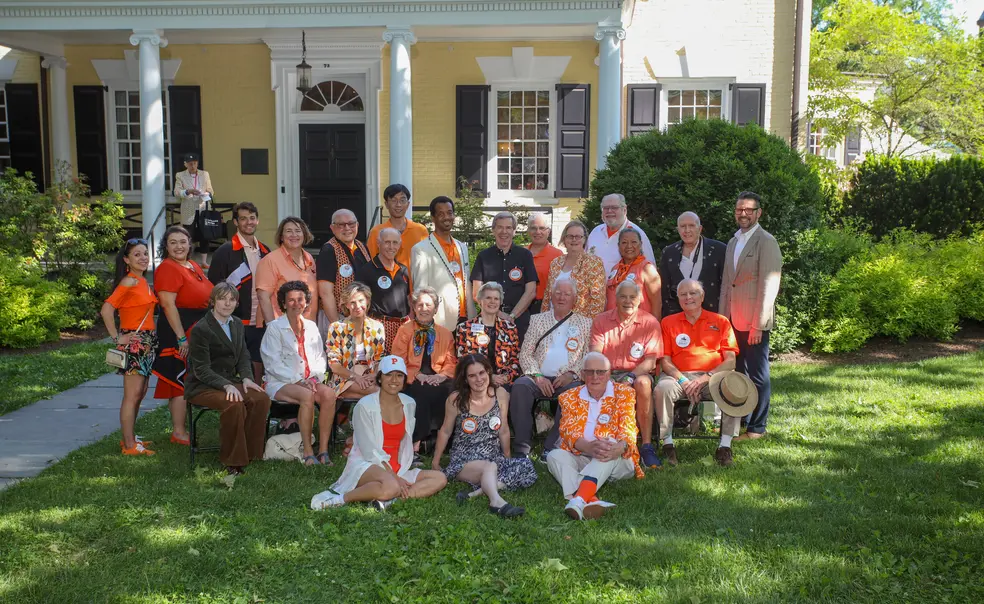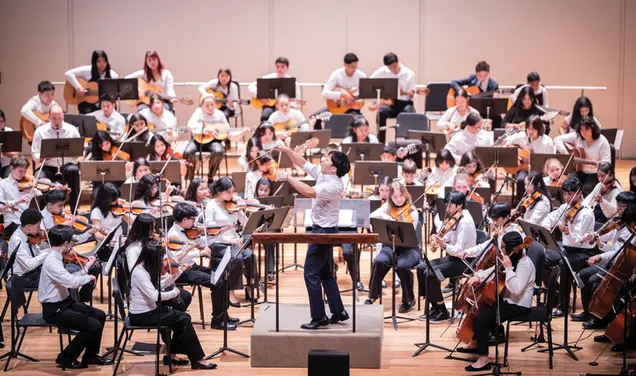Rally ’Round the Cannon: The Secretariat of Alumni Saints
Journalism’s been a continuing course in adult education for me. — Bill Moyers

Here in the History Corner, we’ve never really done justice to one of Princeton’s great spirits of the 20th century, the congenial Henry Martin ’48. One of the cartooning idols at The New Yorker for half their century, along with such as Charles Addams and Saul Steinberg, he never wavered in his adoring attitude toward Princeton, to the extent of churning out his graphic depictions of life’s foibles in a one-room studio just across from the campus. This extended to enhancing our first 125 years here at Your Favorite Periodical through vignettes regarding, unfailingly, the alumni and their precocious/precarious relationship with alma mater. (Balding man on UFO being abducted by aliens incongruously opens a letter, which turns out to be from his college alumni office noting how tough it’s been to track him down.) If there’s ever been a more seasoned joint expert on Princeton activities and the vagaries of magazine publication, I’m at a total loss to conjure up a name.
Which is to introduce the authoritative analysis Martin performed with his facile pen on the occasion of our 75th anniversary lo these 50 years past, in the issue of April 15, 1975. It defines the world of PAW as a celebratory cake (but of course, you knew that…), and goes on to enumerate the crucial elements that make it special in one sense and a comfy part of the family in another:
It takes no concentration, intellect nor sobriety to divine Hank Martin’s (always the name on his Reunions badge) view of the bedrock functions of the magazine. In normal type, LETTERS TO THE EDITOR, an escape-valve mechanism that dramatically reduces the likelihood of alumni mounting an all-out assault on Nassau Hall — at least outside of Alumni Day or Reunions — despite its imminent threat to the personal psyche of the editor, who is assumed to have limitless influence over all University matters fiscal, academic and athletic. And, closest to the Princeton shield and in a unique triple-sized font, just to make it really clear, CLASS NOTES, the volunteer-generated tidbits regarding nonstrategic behavior by random acquaintances that perpetually enthrall those excited fellow Tigers from the Great Class of Whatever, mutually counting the days to the next class dinner and the hours to the next P-rade.
While contesting Hank’s view of the alumni multiverse seems to have little justification, we should also fastidiously add the informed view of Jim Merritt ’66, editor of PAW from 1989-99, who additionally edited the magnum opus The Best of PAW in 2000. That 518-page compendium of 100 years of the magazine opens with his dedication:
To the Class Secretaries
past, present and future
of Princeton University,
whose columns are the soul of PAW
It is an article of faith among those who read the magazine — seemingly, a huge proportion of the universe of alums who receive it — that it’s a back-to-front read, with the initial landing spot being the Class Notes of the recipient and likely those classes immediately surrounding them, where other casual personal acquaintances may lurk. The most recent survey, which showed that a respectable 19% generally read PAW cover-to-cover (a nice number for a general-interest book), revealed almost 90% normally opened it up and at least skimmed it. But the not-so-secret sauce also emerged: 14% of the recipients usually read only the Class Notes. I’d like to go on record as not regarding this as a personal insult, in part because I’ve done it myself on occasion; but you didn’t read it here (14% of you, literally). It has, reassuringly, always been so. The first issue in April 1900 included both Class Notes — although their provenance was murky — and two alumni obituaries. The class secretary, and for many older classes the memorialist to share the burden, have become unshakeable at the core of the PAW layer cake ever since. It is an emphatically peculiar task which, I suspect, would leave even many well-adjusted, verbally adept, well-informed classmates totally adrift; they in fact become cheerleaders for their secretaries, part of a virtual cheering section which does impart individual information — much of it (let’s be blunt) mundane — but below the surface establishes and maintains the warp and weft of the class fabric. The standard secretary’s term is five years, which allows some time to establish taste, style, and personality in the writing, and gives the bond with classmates time to take root and keep the fabric fresh and colorful (well, mainly orange-and-black, but anyway…)
The shrimp and sushi and crostini at the annual PAW reception for class secretaries on the Friday of Reunions are really good. There is justice in this, since that is for all practical purposes their compensation for allowing their contact information to be listed in the public press, and for doggedly keeping up contact with the outlying factions of the class as well as its lawyers, physicians, and captains of binary code. Editor emerita Jane Chapman Martin ’89 actually dug up a class secretary’s handbook from the mid-1930s which opined that (unachievable) ideal notes would mention each classmate at least once each year; additionally, if classmates were not forthcoming with news, one could contact their wives. Those secretaries who tried to follow such guidance, rather than grow their own relationships organically, might be subject to proceeding directly from the PAW Reunions reception directly to the spanking new Frist Health Center for a nice friendly chat.
The very first posting in print of a class secretary’s mailing address, Dr. Thomas W. Harvey 1875 of South Orange, New Jersey, appeared on June 23, 1926. One might suspect that for 25 years most prior notes followed a circuitous path via either the PAW offices or the regular fitful class communication channels, but in essentially no time flat 100% of the secretaries’ names appeared in every issue, and the minor cult of aesthetic sniping took hold, usually in a private note to the sniper’s own secretary, complaining that the nearby Class of Whatsy-what had more interesting notes or better-looking wives or whatever. So do something (unspecified).
Somehow, a remarkable number of game alums have persevered in this unique journalistic calling, and the quality of reportage year-in and year-out has bordered on the miraculous considering the day-to-day life experiences that are most often on display. Many have even taken on the class secretary’s role as a waystation toward other significant alumni work. Dr. Harvey himself composed his class reunion books, one of the most thankless tasks on Earth. Charles Plohn ’66 and Jean Telljohann ’81 have been grand marshals of the P-rade, both thankless and global warming-dependent. Nancy Cassels ’73 was president of the Princeton Club of Canada. Sandy Reynolds ’51 was the chair of Princeton in Asia, served on PAW’s editorial board and the executive committee of the Alumni Council. George Brakeley ’61 founded the Friends of Swimming. Luther Munford ’71 was chair of the Alumni Council. Van Williams ’65 headed the development office; Jo Johnson ’64 was one of his primary lieutenants for many years. Barksdale Penick 1925 served as a University trustee and sat on the first Planned Giving Advisory Committee. Arthur Holden 1912, beyond his seven awards of the Class of 1923 Cane at the P-rade, was a huge supporter of the Friends of the Library. Sally McAlpin s’1920, who took over the column when classmates became few, was with her husband a foundational donor to the art museum. Andrew Imbrie 1895 not only wrote The Faculty Song, but a biography of campus stalwart Jimmy Johnson, “the students friend.” Freddy Fox ’39 was, well, the one and only Freddy Fox.
Then there is a tiny and mighty subset of class secretaries who, out of coincidence of timing, skillsets, and a suspected soupçon of masochism, serve term after term after term and grow into the unofficial historical voice for their mates, often becoming well-known among the larger alumni body. John Laflin ’43 provided crucial unification to his war-shattered class for 27 years; David Reeves ’48 did the same for 40 years. Thirty-five years seemed an informal landmark for the devoted: Ace Bushnell ’47 and Richard Paynter ’51 were seven-timers; Jim Bensen ’36 persevered for 37 years. The ever-upbeat Paul Sittenfeld ’69 handled his Woodstock Nation group with aplomb for 46 years. Selden Edwards ’63 wrote many fine works about Princeton, including 52 years’ worth of Class Notes. But the unchallengeable king is Ralph Ritchie ’34, who reigned over his column for 70 years, and whose many kindly words of advice to other (intimidated) columnists are quoted to this day.
The best class secretaries (including most of those above) can take a mundane event and make it sing; the canard about Class Notes being dull and repetitive itself suffers from shortsightedness more than accuracy. The great minds who (for example) created and nourished the legendary Adelbert Hormone 1917, Ephriam di Kahble ’39, and Joseph D. Oznot ’68 p’01 s’01 are to be treasured. During COVID, class secretary Sandra York ’92 — facing an understandable dearth of vibrant news — even held a haiku contest. This from classmate John Granholm:
Virgin reunions
goer plans on 30th
for debut. Can’t wait …
Dei sub numine viget.











No responses yet